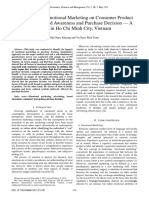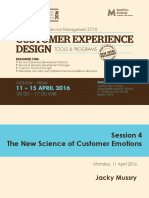How can companies use emotions to attract customers?
Introduction: In an increasingly competitive marketplace, companies are constantly seeking innovative
ways to capture the attention and loyalty of consumers. One powerful tool in their arsenal is the
strategic use of emotions. Emotions play a significant role in consumer decision-making, influencing
purchasing behavior, brand perception, and long-term loyalty. This essay explores how companies can
effectively harness emotions to attract customers, examining various strategies and their impact on
consumer engagement and brand success.
Understanding Emotional Appeal: Emotional appeal involves tapping into consumers' feelings, desires,
and aspirations to create a meaningful connection with a brand or product. By evoking specific emotions
such as joy, nostalgia, excitement, or empathy, companies can create memorable experiences that
resonate with their target audience. Emotional branding goes beyond product features or benefits; it
seeks to build emotional bonds that foster customer loyalty and advocacy.
Creating Emotional Connections: To attract customers effectively, companies must identify the
emotions that resonate most strongly with their target demographic and align their branding and
marketing efforts accordingly. For example, a luxury fashion brand might evoke feelings of exclusivity
and aspiration, while a family-friendly restaurant chain may focus on warmth and nostalgia. By
understanding their audience's emotional triggers, companies can craft messaging, imagery, and
experiences that elicit the desired response.
Storytelling and Brand Narrative: Storytelling is a powerful tool for creating emotional connections with
consumers. Companies can use storytelling to humanize their brand, share their values and mission, and
engage customers on a deeper level. By weaving narratives that evoke emotion and resonate with the ir
audience's experiences and aspirations, companies can differentiate themselves in a crowded
marketplace and forge lasting relationships with customers.
Authenticity and Transparency: Authenticity is essential in emotional marketing. Customers are drawn
to brands that are genuine, transparent, and aligned with their values. Companies must demonstrate
authenticity in their actions, communications, and brand experiences to build trust and credibility with
consumers. Authentic emotional connections cannot be manufactured; they must stem from a genuine
commitment to understanding and meeting customers' needs and desires.
Using Visual and Sensory Cues: Visual elements such as color, imagery, and design play a crucial role in
evoking emotions and shaping brand perception. Companies can leverage these visual cues to create
immersive brand experiences that resonate with consumers on an emotional level. Similarly, sensory
marketing techniques such as scent, sound, and texture can evoke powerful emotions and enhance the
overall customer experience.
Measuring Emotional Impact: While emotional marketing can be highly effective, measuring its impact
can be challenging. Companies can use a combination of qualitative and quantitative methods, including
customer surveys, focus groups, and brand tracking studies, to assess the emotional resonance of their
marketing efforts. By understanding how emotions influence consumer behavior and brand perception,
companies can refine their strategies and optimize their marketing investments for maximum impact.
Conclusion: In today's competitive business landscape, emotions are a powerful currency for attracting
and retaining customers. By understanding their audience's emotional drivers, crafting compelling brand
�narratives, and fostering authentic connections, companies can create meaningful experiences that
resonate with consumers and drive long-term loyalty. Emotions are not just a marketing tactic; they are
the foundation of successful customer relationships in the digital age.


























































































